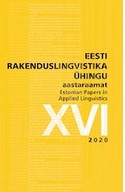VENEKEELSETE KOHANIMEDE EDASIANDMISEST EESTI KEELES
ON THE TRANSPOSITION OF RUSSIAN PLACE NAMES INTO ESTONIAN
Author(s): Sirje Kupp-Sazonov, Oksana PalikovaSubject(s): Comparative Linguistics, Finno-Ugrian studies, Eastern Slavic Languages, Translation Studies
Published by: Eesti Rakenduslingvistika Ühing (ERÜ)
Keywords: street names; translation; transcription; Estonian; Russian;
Summary/Abstract: This article focuses on the problem of translating Russian place names into Estonian. The topic is relevant for legal translators whose daily work involves translating various documents that contain addresses. It important that place names (addresses) in the translated text be correctly “re-translatable” back into the source language. The aim of our study is to compare advice given in literature on the subject (theory) on the one hand to real translators’ strategies (practice) on the other. There exist recommendations from a variety of sources and these recommendations are different for different languages. The main idea is that one should translate the part of the proper Russian noun which includes the common name (with lexical meaning) and then “restore” the origin of the part which is derived from the proper noun and formulate it in Estonian. This means that the translator should find the place name used for composing the name of the district or other type of administrative division. These recommendations end with a suggestion to differentiate between the fundamental end goals of translating legal texts and fictional texts. To find out what happens in real translation practice we composed a set of questions in which we asked sworn, court and police translators to transpose Russian place names into Estonian. Our respondents demonstrated very different strategies: from total translation (площадь Энергетиков – Energeetikute väljak ‘Power engineers square’) to transliteration (the transposition of the letters, not the sounds: ploštšad Energetikov). Some examples of partial transcription were also to be found: Energetikov väljak ‘Energetikov square’. There were barely any examples of place names that translators had transposed identically. Data collected from the questionnaire showed that there are quite large differences between theory and practice.
Journal: Eesti Rakenduslingvistika Ühingu aastaraamat
- Issue Year: 2020
- Issue No: 16
- Page Range: 125-139
- Page Count: 15
- Language: Estonian

